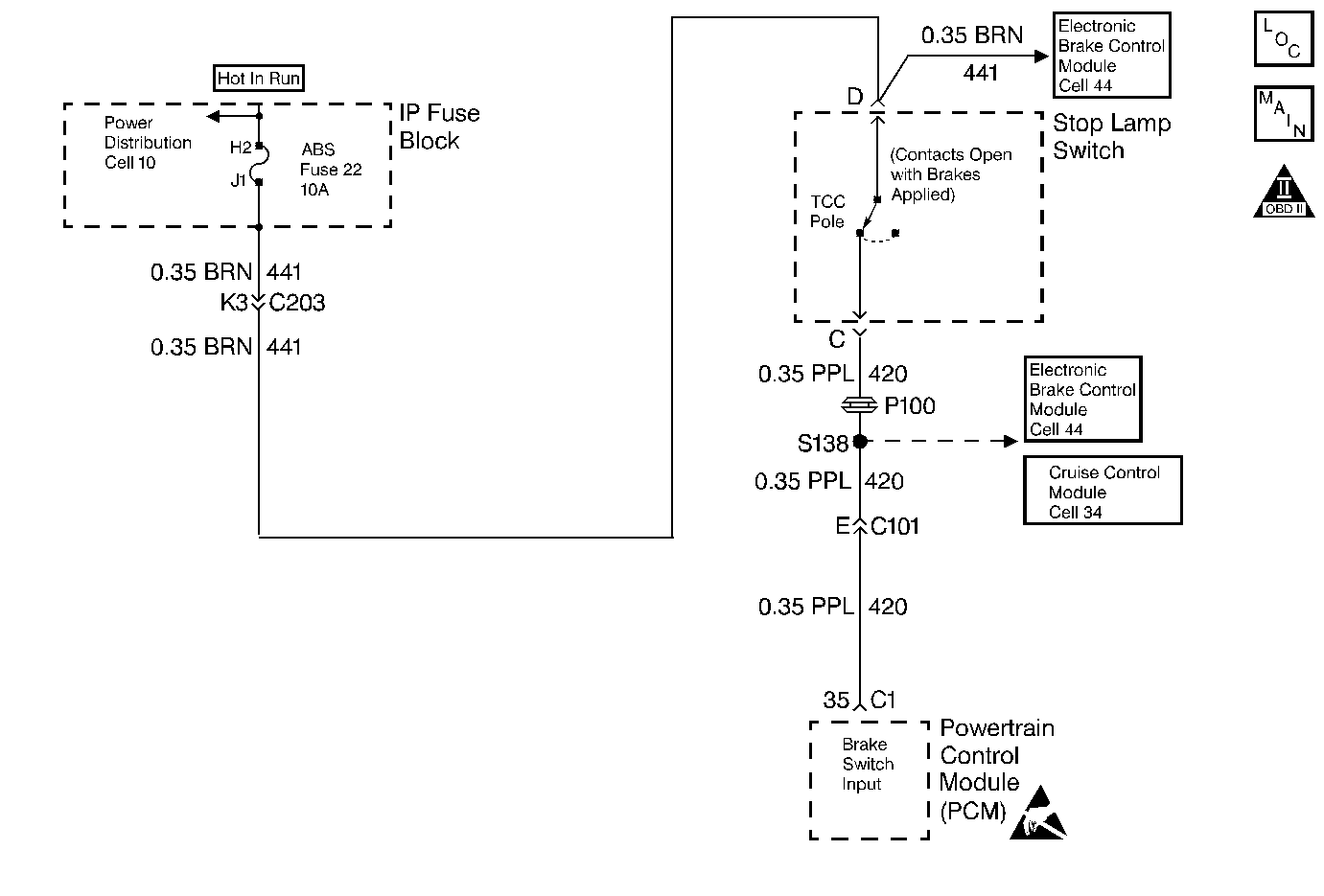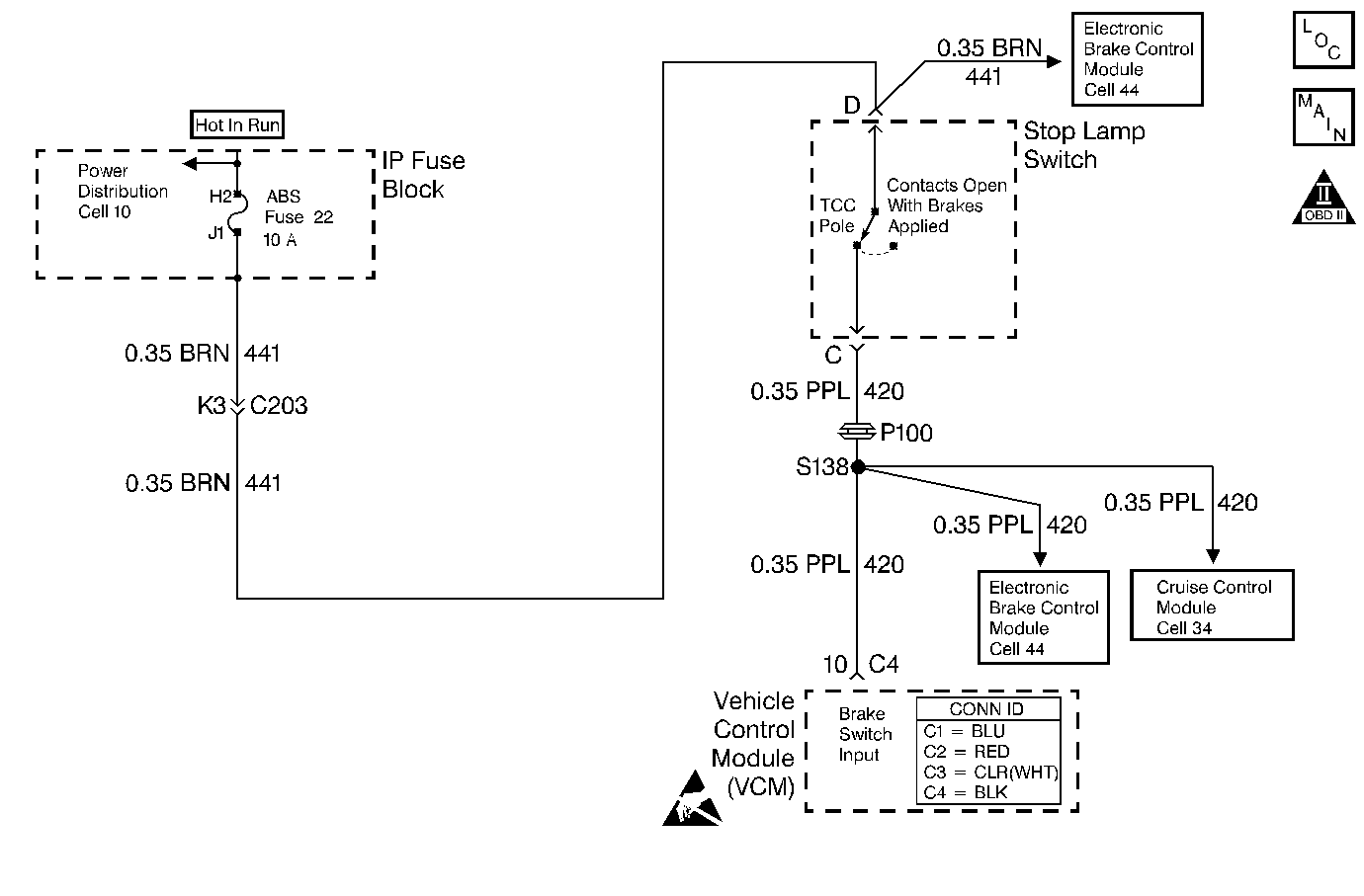DTC P0719 Brake Switch Circuit Low Input 2.2L

Circuit Description
The brake switch indicates brake pedal status to the Powertrain Control Module (PCM). The brake switch is a normally-closed switch that supplies battery voltage on circuit 420 to the PCM. Applying the brake pedal opens the switch, interrupting voltage to the PCM. When the brake pedal is released, the PCM receives a constant voltage signal. If the PCM receives a zero voltage signal at the brake switch input, and the Torque Converter Clutch (TCC) is engaged, the PCM de-energizes the Torque Converter Clutch Solenoid Valve (TCC Sol. Valve). The PCM disregards the brake switch input for TCC scheduling if there is a brake switch circuit fault (Refer to Diagnostic Aids).
When the PCM detects an open brake switch circuit (0 volts, low input) during accelerations, then DTC P0719 sets. DTC P0719 is a type D DTC.
Conditions for Setting the DTC
| • | No VSS Assy. DTCs P0502 or P0503. |
| • | The PCM detects an open brake switch circuit (0 volts) for 15 minutes without changing for 2 seconds, and the following events occur seven consecutive times: |
| - | The vehicle speed is less than 8 km/h (5 mph); |
| - | then the vehicle speed is 8-32 km/h (5-20 mph) for 4 seconds; |
| - | then the vehicle speed is greater than 32 km/h (20 mph) for 6 seconds. |
Action Taken When the DTC Sets
| • | The PCM does not illuminate the Malfunction Indicator Lamp (MIL). |
| • | DTC P0719 stores in PCM history. |
Conditions for Clearing the DTC
| • | A scan tool can clear the DTC from the PCM history. The PCM clears the DTC from the PCM history if the vehicle completes 40 warm-up cycles without a failure reported. |
| • | The PCM cancels the DTC default actions when the fault no longer exists and the ignition is OFF long enough in order to power down the PCM. |
Diagnostic Aids
| • | Inspect the wiring at the PCM, the brake switch connector and all other circuit connecting points for the following conditions: |
| - | A bent terminal |
| - | A backed out terminal |
| - | A damaged terminal |
| - | Poor terminal tension |
| - | A chafed wire |
| - | A broken wire inside the insulation |
| - | Moisture intrusion |
| - | Corrosion |
| • | When diagnosing for an intermittent short or open condition, massage the wiring harness while watching the test equipment for a change. |
| • | If the PCM detects a brake switch circuit fault, then the brake switch input is disregarded for TCC scheduling. The PCM then uses throttle position and vehicle speed to determine TCC application and release. Use of these inputs may result in a noticeable harsh apply or abrupt release of the TCC. |
| • | Ask about the customer's driving habits. Ask about unusual driving conditions (e.g. stop and go, expressway, etc.). |
| • | Inspect the brake switch for proper mounting and adjustment. |
| • | Inspect for ABS DTCs. A faulty ABS condition may contribute to setting DTC P0719. |
Test Description
The numbers below refer to the step numbers on the diagnostic table.
Step | Action | Value(s) | Yes | No |
|---|---|---|---|---|
1 | Was the Powertrain On-Board Diagnostic (OBD) System Check performed? | -- | ||
2 |
Important: Before clearing the DTC(s), use the scan tool in order to record the Failure Records for reference. Using the Clear Info function will erase the stored Failure Records from the PCM. Is the test lamp ON? | -- | ||
Install a fused jumper wire from terminal C to terminal D of the brake switch connector. Did the TCC Brake Switch status change from Open to Closed? | -- | |||
4 | Remove the ABS fuse. Inspect the fuse for an open. Refer to General Electrical Diagnosis . Is the fuse open? | -- | ||
5 |
Refer to General Electrical Diagnosis . Did you find a short to ground condition? | -- | ||
6 |
Refer to General Electrical Diagnosis . Did you find a short to ground condition? | -- | ||
7 | Replace the brake switch. Refer to Stoplamp Switch Replacement. Is the replacement complete? | -- | -- | |
8 |
Refer to General Electrical Diagnosis . Did you find an open condition? | -- | -- | |
9 |
Refer to General Electrical Diagnosis . Did you find an open condition? | -- | ||
10 | Replace the PCM. Refer to Powertrain Control Module Replacement/Programming . Is the replacement complete? | -- | -- | |
11 | In order to verify your repair, perform the following procedure:
Has the test run and passed? | -- | System OK |
DTC P0719 Brake Switch Circuit Low Input 4.3L

Circuit Description
The brake switch indicates brake pedal status to the Vehicle Control Module (VCM). The brake switch is a normally-closed switch that supplies battery voltage on circuit 420 to the VCM. Applying the brake pedal opens the switch, interrupting voltage to the VCM. When the brake pedal is released, the VCM receives a constant voltage signal. If the VCM receives a zero voltage signal at the brake switch input, and the Torque Converter Clutch (TCC) is engaged, the VCM de-energizes the Torque Converter Clutch Solenoid Valve (TCC Sol. Valve). The VCM disregards the brake switch input for TCC scheduling if there is a brake switch circuit fault (Refer to Diagnostic Aids).
When the VCM detects an open brake switch circuit (0 volts, low input) during accelerations, then DTC P0719 sets. DTC P0719 is a type D DTC.
Conditions for Setting the DTC
| • | No VSS Assy. DTCs P0502 or P0503. |
| • | The VCM detects an open brake switch or circuit (0 volts) for 15 minutes without changing for 2 seconds, and the following events occur seven consecutive times: |
| - | The vehicle speed is less than 8 km/h (5 mph); |
| - | then the vehicle speed is 8-32 km/h (5-20 mph) for 4 seconds; |
| - | then the vehicle speed is greater than 32 km/h (20 mph) for 6 seconds. |
Action Taken When the DTC Sets
| • | The VCM does not illuminate the Malfunction Indicator Lamp (MIL). |
| • | DTC P0719 stores in VCM history. |
Conditions for Clearing the DTC
| • | A scan tool can clear the DTC from the VCM history. The VCM clears the DTC from the VCM history if the vehicle completes 40 warm-up cycles without a failure reported. |
| • | The VCM cancels the DTC default actions when the fault no longer exists and the ignition is OFF long enough in order to power down the VCM. |
Diagnostic Aids
| • | Inspect the wiring at the VCM, the brake switch connector and all other circuit connecting points for the following conditions: |
| - | A bent terminal |
| - | A backed out terminal |
| - | A damaged terminal |
| - | Poor terminal tension |
| - | A chafed wire |
| - | A broken wire inside the insulation |
| - | Moisture intrusion |
| - | Corrosion |
| • | When diagnosing for an intermittent short or open condition, massage the wiring harness while watching the test equipment for a change. |
| • | If the VCM detects a brake switch fault, then the brake switch input is disregarded for TCC scheduling. The VCM then uses throttle position and vehicle speed to determine TCC application and release. Use of these inputs may result in a noticeable harsh apply or abrupt release of the TCC. |
| • | Ask about the customer's driving habits. Ask about unusual driving conditions (e.g. stop and go, expressway, etc.). |
| • | Inspect the brake switch for proper mounting and adjustment. |
| • | Inspect for ABS DTCs. A faulty ABS condition may contribute to setting DTC P0719. |
Test Description
The numbers below refer to the step numbers on the diagnostic table.
Step | Action | Value(s) | Yes | No |
|---|---|---|---|---|
1 | Was the Powertrain On-Board Diagnostic (OBD) System Check performed? | -- | ||
2 |
Important: Before clearing the DTC(s), use the scan tool in order to record the Failure Records for reference. Using the Clear Info function will erase the stored Failure Records from the VCM. Is the test lamp ON? | -- | ||
Install a fused jumper wire from terminal C to terminal D of the brake switch connector. Did the TCC Brake Switch status change from Open to Closed? | -- | |||
4 |
Refer to General Electrical Diagnosis Procedures. Is the fuse open? | -- | ||
5 |
Refer to General Electrical Diagnosis Procedures. Did you find and correct a short to ground condition? | -- | ||
6 |
Refer to General Electrical Diagnosis Procedures. Did you find and correct a short to ground condition? | -- | ||
7 | Replace the brake switch. Refer to Stoplamp Switch Replacement. Is the replacement complete? | -- | -- | |
8 |
Refer to General Electrical Diagnosis Procedures. Did you find and correct an open condition? | -- | -- | |
9 |
Refer to General Electrical Diagnosis Procedures. Did you find an open condition? | -- | ||
10 | Replace the VCM. Refer to VCM Replacement/Programming . Is the replacement complete? | -- | -- | |
11 | In order to verify your repair, perform the following procedure:
Has the test run and passed? | -- | System OK |
